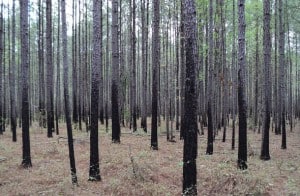Share this article
Changes in forest condition contribute to pollinator decline
Forests in North America have changed rapidly over the past century. Before European settlement, forests were a mosaic of open pine and hardwood forests, prairies, and woodland savannas. Recent studies have found that forests with sun-filled openings and those with open canopies — where the branches from adjacent trees don’t touch or overlap — favor pollinators like bees and butterflies.
However, North American forests have shifted towards closed canopies, resulting in less light reaching the forest floor. Underneath the canopy, many of these forests have dense layers of shrubs. The changes have been profound and could be contributing to pollinator decline.

Dense stands of young pine trees support few pollinators. ©Jim Hanula, U.S. Forest Service
Jim Hanula, research entomologist at the Forest Service Southern Research Station Insects, Diseases, and Invasive Plants research unit (now retired), and his colleagues measured bee abundance and diversity across seven types of forest, including: cleared forest, dense young pines, thinned young pines, mature open pine with extensive shrub and sapling cover, mature open pine with extensive herbaceous plant cover, mature upland hardwood forest, and mature riparian hardwood forest.
Researchers measured the plant communities in each of these forests and the amount of light reaching the forest floor.
The study took place in the Oconee National Forest in Georgia. Before becoming part of the National Forest System in 1959, farmers had gown cotton on the land, and it was almost totally deforested. The land use history of the Oconee National Forest is shared by many other forests in the Southeast, where huge swathes of forests were clearcut during the late 1800s and early 1900s.
As a result of widespread deforestation as well as repeated forest fires that swept through the remaining forests, the primary conservation goals throughout much of the last century were reforestation and wildfire prevention. The scale of reforestation needed was so vast that in 1930, pioneering forester Philip Wakeley predicted it would take centuries to complete. Although reforestation was completed much more quickly than expected, the secondary forests often had closed canopies and denser shrub layers.
“We found that bees were most abundant in mature pine forests with open canopies with flowers and grasses in the understory that provide long-term, stable habitats for bees,” said Hanula. Pollinators were also common in recently cleared patches of forests, but those stands tend to quickly close and become dense stands of young pine trees that the study found tended to support the fewest bees. Total tree basal area was the best predictor for how many bees would be present – in stands that had many trees and high basal areas, bees were scarce. Bees were also less common in stands with dense shrub layers.
The results have already been incorporated into bee-friendly management principles for federal lands. Hanula and co-author Scott Horn, an SRS entomologist, were part of a Forest Service team that developed the 2015 pollinator-friendly best management practices for federal lands.
One of the principles discussed in the report is how open forests benefit bees. Maintaining open-canopy pine forests with diverse herbaceous communities typically requires prescribed fire. Fortunately, pollinator conservation is compatible with other goals such as maintaining habitat for the endangered red-cockaded woodpecker. Thinning dense pine stands could also have forest health benefits, since crowded trees are more susceptible to southern pine beetle and European woodwasp infestations.
Without insect pollination, many plants would be unable to reproduce. “Pollinators are critically important to both forest ecosystems and to people,” said Hanula. “Managing for open forests has a number of benefits, and will also help sustain these small creatures.”
Read the full text of the article.
Access the Pollinator-Friendly Best Management Practices for Federal Lands.
For more information, email James Hanula at jhanula@fs.fed.us.
Header Image: ©Lal Beral








